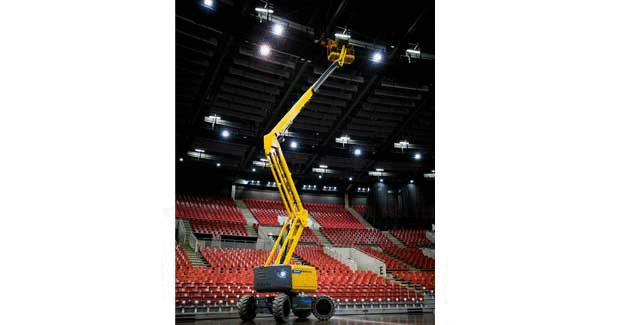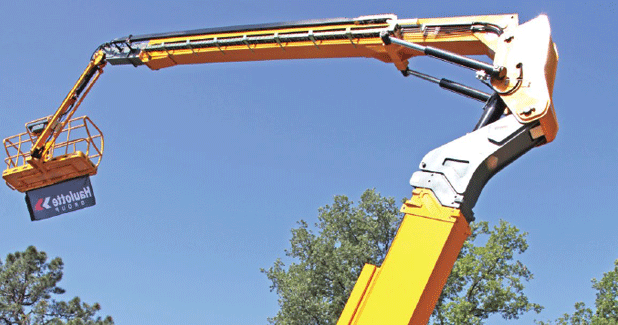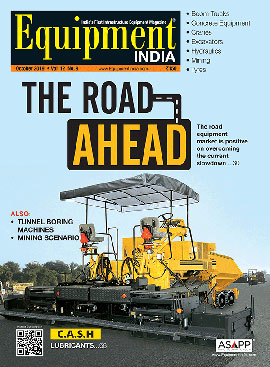Search

Steps to Safety
Being the safest means of working at heights, Aerial Work Platforms (AWPs) are naturally the option to work at height safely. However, use of AWPs in India is still limited and is picking up slowly.

Accessing Heights, Safely
As the access equipment industry matures in India and users become more aware on the advantages of using such equipment over conventional practices of working at heights, the rental sector in India is poised for a very bright and promising future.

Many German companies plan to invest more in India
An overwhelming majority of bC India exhibitors (79 per cent) expect the economy in the region to improve and to continue growing, says Rajesh Nath, Managing Director, VDMA India Services.

Optimistic About 2014
The German construction equipment and building material machinery industry is in an optimistic mood as incoming orders are currently up by seven per cent.Compared to the previous year, turnover of the German construction equipment and building material machinery industry declined slightly in 2013 by six per cent to the current figure of ?11.7 billion. Nevertheless, the industry is entering 2014 in an optimistic mood. Incoming orders for construction equipment are currently up by seven per ce

The Haulotte Group strategy is driven by customer proximity.
Haulotte Group is one of the key global players of people and material lifting equipment, a leader in Europe and the third largest manufacturer worldwide. Their success is primarily due to a strong focus on innovation and safety. It is our concern for customer proximity which has driven Haulotte's international development of business and strategy over the last 15 years, says Alexandre Saubot,Chief Executive Officer, Haulotte Group. Excerpts from the interview.

bC India affords excellent opportunity for UK manufacturers to access Indian market
The CEA aims to assist its OEM members by exposing them to users and distributors in India and UK component member companies, by introducing them to manufacturers in India looking to expand their supply chain and identify gaps in domestic production, says Joanna Oliver MBE, Director of Global Programmes, Con?struction Equipment Association, CEA, (UK)

India presents a vast potential for overseas investment, and VDMA acts as a bridgehead
The bC India show will facilitate closer interaction among German technology suppliers and the Indian construction industry, paving the way for increased global interest in the Indian market. Hence it would be a ?win-win? situation for the industry, says Rajesh Nath, Managing Director, VDMA India. Excerpts from the interview.

Our vision is to provide a high-quality package for road construction
It is not just about a machine, more importantly, it?s about optimal use of scant resources and how recycling can help achieve the objective of deve?lopment with more economical and environment-friendly methods.

Confidence Quotient
'Vision 2020: Commanding New Heights', a study on the CE industry by the Confederation of Indian Industry (CII) and the Indian Earthmoving and Construction Industry Association (IECIAL),

CE sector on cusp of boom
Infrastructure spending will drive construction equipment (CE) growth. As per the 12th Five Year Plan estimates released, the following is the spending envisaged:

India is a key market, and we are strongly committed to its growth
Based on our 10 year plan, by 2020 we hope to be able to secure about five per cent of the whole construction equipment market share in India which comes up to half a billion US dollars. That is our target and we hope that we can progressively move towards that. 1 - -
22720 14 102 2011-12-01 00:00:00.000 Agith G Antony Racing Ahead The Indian CE section, at present the fifth largest CE market in the world, is tipped to become the second largest CE market by 2015, and by value terms, to reach 15 billion by 2015, and a whooping 20 billion by 2020. The ongoing race to stand tall and deliver is slowly but steadily changing the rules of the game. Agith G Antony trains his gaze on the changing CE horizon.
Ask any of the global OEMs who have set up shop here long ago or in the last couple of years, or for that matter, eask any new entrant how they perceive the potential of the Indian market. Their response is invariably couched in cliches: 'India is a key market and if you are not in India, there is something amiss with your business strategy.' Truth to tell, that response reveals the track on which the growing CE industry is heading.
"India is a key market and we are strongly committed to its growth," says Sew Chee Jhuen, President, Singapore Technologies Kinetics, which has recently forayed into the Indian CE market with the launch of a motorgrader. "For the new plant, we are pumping in around $15-20 million. Our total investment planned for next few years is $35 million. We are not limiting ourselves to this alone; we plan to build another factory very soon in India," he further adds.
At a recent press meet, Vipin Sondhi, Managing Director & CEO, JCB India stated, "We have no option as a country but to invest in infrastructure at all points in time." It is quite possible that the statement reflects what is in store for the construction equipment industry, and how OEMs are charting their business strategies to acquire a major share of the market.
The Prognos World Report, released way back in 1995, indicated that the classic industrial countries will only be contributing a third to worldwide growth by the year 2025, whereas, following the same timeline, the Indian economy was tipped to be a major catalyst stimulating international business growth. Today, India has emerged as one of the nations shaping world economy, a preferred investment destination and one of the world's most rapidly growing markets. Its national economy, its demographic structure and its high, sustained rate of growth has tagged India as the second most important market after China, coupled with the fact that contrary to China, domestic demand is already a strong development factor.
It's crystal clear: the role of India in the world economy has become so pivotal, certainly not because of the recent crisis, (though that must have accelerated matters, of course) but simply because of the huge potential India holds as a fast developing country. As per reports, the mid-term forecast for the next five years indicates that the gross domestic product in Europe and the US will grow at moderate annual rates while emerging markets such as China, India and Brazil are expected to maintain a much higher growth. The economic crisis, as well as the recovery after it, certainly had its impact in the global construction equipment market. For global OEMs with diversified enterprises, harsh impact in particular markets were largely offset by positive development in others. In fact, the total investment of many an OEM has gone up to considerably high levels again.
The dramatic shift in terms of sales of construction equipment from classic markets to BRIC nations is already evident as more global players are anchoring alongside the Indian shoreline. Over the last half decade, the number of global OEMs entering the Indian market has shot up; this includes major players from Japan, US, Germany, Korea, etc. On the other hand, domestic companies have also been either expanding their domestic capacities or diversifying their product portfolio. The result - with the emergence of new market players and expansion plans underway, the industry is expected to become more competitive and as a result, more fragmented.
Says DK Vyas, Chief Executive Officer, Srei BNP Paribas, "As per our estimates, the present organised equipment market for infrastructure and construction equipment (ICE) in India should be anything around Rs 24,000-28,000 crore ($4.7-5.5 billion). Thus, the construction equipment financing industry should be pegged at around 85 per cent of this figure. The growth of the ICE sector will be healthy. Our calculations tell us, when our GDP grows at 9 per cent annually, the annual growth rate of the ICE sector is at around 30 per cent. But in a worst case scenario, if the annual GDP growth rate even slows down to 6 per cent, the annual growth rate for ICE will be around 20 per cent. With such growth prospects, it is no wonder that global ICE majors are making a beeline to India and setting up shops here."
The construction equipment manufacturing industry estimates that CE demand will cross 100,000 units during 2014, whereas the contribution of the CE rental business, perceived to be another growth driver, is expected to double from the present seven to eight per cent of the size of the global industry to 16 per cent by 2015. Even though the industry spirit is currently dampened due to the volatility in oil and commodity prices and inflationary pressures, and to some extent, the alleged scams and corruption charges, the overall picture is quite positive and the sector is bound to see growth every year, propelled by government policies and support from the private sector.
As the rules of the game change, so do the trends. The increasing dominance of price-and-value focused customers, increasing awareness on the utility and versatility of specialised equipment, deeper engagement of global equipment manufacturers in India, increasing opportunities for exports and last, but not the least, the emission norms and greater emphasis on reducing the negative impact on environment, have been moulding the CE industry's trajectory onto a more responsible path as never before.
The emphasis today clearly is on creating capacity and backing it up with dealer networks and efficient service. As per sources , India will need an infusion of $1 trillion investment during the 12th Five Year Plan; there is no doubt though that the country has become one of the top priority markets for many global OEMs. A mere glance over the past five years' growth supports this fact.
As research inputs suggest, companies need to pursue four growth-enabling initiatives to expand the market. These include enhancing the quality, delivery and price of after sales services to increase share of service revenues from two per cent of total revenues to the global average of about eight per cent; addressing key gaps in financing to catalyse latent demand particularly in rural areas and small towns; expanding dealer and channel network coverage to address buyer fragmentation and quality, and proactively strengthening supplier capacities and capabilities.
The increasing competition from product imports from other low-cost countries that could potentially challenge the industry growth and the ever-increasing input costs have been a major challenge for the industry. To address these issues and achieve full potential in the market, OEMs have embarked on strategic initiatives: introducing India- specific products that includes low-priced multi-purpose equipment to attract new customers and to increase mechanisation in important areas; improving cost positions to better deal with the onslaught of competition from LCCs; and pioneering efforts to boost exports in areas like engineering and design services that leverage India's technical prowess.
Another perceptible shift is towards green procurement. Customers who rely on energy-efficient and environment-friendly machines will have an advantage over their competitors. The increasing fragmentation of the industry, with more players setting up production facilities for specialised machines, is an indicator of the industry going greener.
The Bharat Stage-IV norms are already in effect for automobiles and the BS-III is now in effect for most other segments except gensets; in all, it constitutes a major initiative to bring down the carbon footprint. One of the challenges faced by the manufacturers of diesel engines today is to develop products that will deliver higher performance, longer life, lower operating costs and at the same time, with less of an environmental impact. To comply with these standards, engine manufacturers have invested in the research and development of new, cutting-edge technologies aimed at taking diesel emissions levels to near zero. It's heartening to note that JCB has already launched the ecoMAX customised for Indian conditions and emission norms; Mahindra Navistar Engines will introduce a 4-cylinder engine to the Indian market for various genset and construction equipment; Cooper has moved up the value chain through a logical diversification in the engine and auto?motive manufacturing business and has launched a multipurpose, flexi-fuel, twin-cylinder engine, for which commercial production has already begun.
But on the flip side, the rising input costs and lack of a clear-cut road map for clean fuel are major deterrents. Another major challenge is to bring down the technology gap between the organised and unorganised segments. Ironically, while every other sector has been moving towards reducing emissions caused by engines, the genset industry has been largely inactive. There was even a move to extend the deadline for introducing the new norms for gensets. Thanks to the tireless efforts of some of the manufacturers, the deadline of 1 October 2013 stays effective and not only that, most of the manufacturers have already geared up for these new norms; some of them have already introduced their lower emission diesel engines into the market.
The point is, the unorganised sector neither has the resources nor the technology to develop such engines. Concerted efforts from the Central Pollution Control Board (CPCB), Delhi and the Association of Diesel Engine Manufacturers Association (IDEMA) and unorganised segments , could dramatically reduce the technology gap, thereby reducing emissions from diesel engines. With this in place, we can look forward to a cleaner and greener industry.
More importantly, more and more OEMs are charting different routes other than the classic ways of sales and service, to make it more holistic in terms of product offerings and relations with clients. Some leading OEMs have already started implementing the concept of MARC, though not to the fullest extent as it exists in the developed markets. Still, EI believes it's a good beginning.
A recently released report from the United Nations Industrial Development Organisation (UNIDO) forecasts that the world's manufacturing output growth will be slower this year, compared to the last year. As per the report, the developing countries have maintained high growth rates of manufacturing with production increasing by 11.1 per cent. For 2011, the MVA growth of industrialised countries is likely to be around 3.2 per cent, whereas that of developing countries is expected to grow by 8.4 per cent. Clearly, India and China are where the action is.
The role of India in the world economy has become so pivotal, certainly not because of the recent crisis, (though that must have accelerated matters, of course) but simply because of the huge potential India holds as a fast developing country.

We will be investing in new product lines and aim to cross the $500-mn turnover mark by 2015
In a significant strategic decision, Terex Corp has recently acquired Demag Cranes, world?s leading German manufacturer of all kinds of cranes, for nearly $1.5 billion.

Liebherr is committed to strengthening its presence in India
?Liebherr is investing in production facilities in all BRIC nations, permanently extending its sales and service network and investing in especially adapted products for these markets,? says Ajay Kumar Somani, Representative Director & Head - Mobile Crane Division, Liebherr India.

We will be a 500 million company by 2015
Sounding both pragmatic and optimistic about Terex India?s growth, Jehangir Ardeshir, President and Managing Director, Terex India talks about the company?s future to Equipment India.

We are expecting a double digit growth during the next five years
BRIC nations will become much more sustainable and stable. The dynamics of these imp?ortant emerging markets are going to demand huge levels of investment in infr?astructure, which will serve construction equipment manufacturers well over the long term,? says Damian Power, Global Product Line Director, Powerscreen.

Our focus is to strengthen and improve our after sales service including training
?We are looking at tripling our turnover in the next five years which will be contributed partly by increase in demand within our country, says Anand Sundaresan, Chief Executive Officer, Schwing Stetter India.

JCB is the only manufacturer to produce and sell 100,000 machines in India
?The world is looking towards BRIC nations to lead the global recovery. We?ve been able to reach this position with the right investments at the right time, says Vipin Sondhi, Managing Director and CEO, JCB India.

CE Boom Heads East
Even as the American and European markets continue to languish after the global economic crisis, the world is looking towards the BRIC nations (Brazil, Russia, India and China) to lead the recovery.



 +91-22-24193000
+91-22-24193000 Subscriber@ASAPPinfoGlobal.com
Subscriber@ASAPPinfoGlobal.com